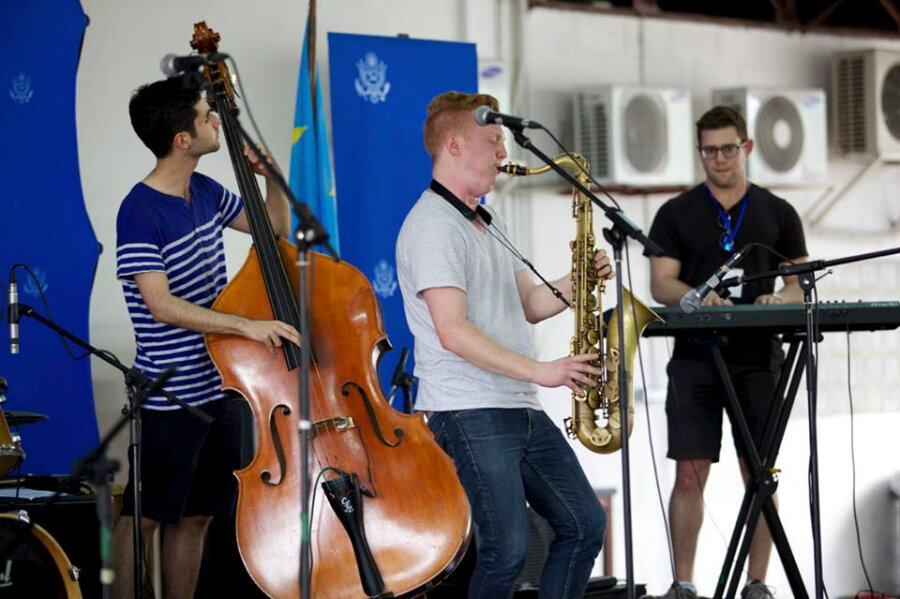Out of My Own Way: Adam Larson Speaks
 Saxophonist Adam Larson has had a very busy spring. A few weeks ago, Larson returned to New York after a month-long tour through Africa sponsored by the US State Department. Larson and his group taught and performed in Kinshasa, Congo; Dakar, Senegal; Accra, Ghana; and elsewhere. Since his return to the city, Larson has been hard at work preparing to record his next record, his first for Greg Osby's Inner Circle Music label. He's been working on charts, rehearsing with his top-flight band, and raising funds for the project through Indiegogo.Larson and company will head into the famed Sear Sound Studio this Saturday, June 6th, but first, they will preview their new music at The Jazz Gallery on Friday the 5th. We at Jazz Speaks caught up with Larson by phone this week to hear about his African tour and what to expect on the new record.The Jazz Gallery: So was this your first time in Africa?
Saxophonist Adam Larson has had a very busy spring. A few weeks ago, Larson returned to New York after a month-long tour through Africa sponsored by the US State Department. Larson and his group taught and performed in Kinshasa, Congo; Dakar, Senegal; Accra, Ghana; and elsewhere. Since his return to the city, Larson has been hard at work preparing to record his next record, his first for Greg Osby's Inner Circle Music label. He's been working on charts, rehearsing with his top-flight band, and raising funds for the project through Indiegogo.Larson and company will head into the famed Sear Sound Studio this Saturday, June 6th, but first, they will preview their new music at The Jazz Gallery on Friday the 5th. We at Jazz Speaks caught up with Larson by phone this week to hear about his African tour and what to expect on the new record.The Jazz Gallery: So was this your first time in Africa?
Adam Larson: It was, yeah. We went to four different countries while we were there. It was a tour sponsored by the US State Department and it's administered by an NGO called American Music Abroad who host auditions annually to find ten different groups to go out to all different places around the world. For 2014-2015, we were one of two jazz groups that got sent out.
TJG: When you hear State Department and jazz, it's easy to think about those tours in the '50s and '60s with Louis Armstrong and Dave Brubeck and Dizzy Gillespie that were used to promote American interests during the Cold War. I feel today that the purpose of this kind of trip is a little bit different, so what were the different kinds of things you did on tour in terms of performing or teaching?
AL: It was kind of amazing because one of the places where we got to work with local musicians in a masterclass/workshop kind of thing was at the Sorano Theater for the Arts, which is in Dakar, Senegal, and that's where Louis Armstrong and Duke Ellington and a lot of other famous musicians on state department tours performed. So that was a really cool experience.But with American Music Abroad, the idea is to do a lot of collaborations, so we worked with a lot of different age groups—kids as young as eight all the way through adults. We worked with some professional ensembles, some students. It was all about sharing the American jazz art form. I think probably all of the groups we worked with hadn't heard swing or straight-ahead jazz, so that was cool to work with and expose people to American jazz.We certainly learned a lot about the rhythmic traditions that inform so much of American jazz, since those all come from West Africa. It was incredible to be in the world where all that is sourced from. So much of the music we heard over there was rhythmically-driven, so it was eye-opening to be in that environment for five weeks.
TJG: Was there anything in particular that surprised you about your experience on tour?
AL: I think one thing that surprised me more than anything else was that nothing seemed to run on time! It was really difficult for the first week and a half before we could get adjusted to that.But by and large, I think the audiences really enjoyed the music. You could see some confused faces when we were playing straight-ahead jazz. But I like to write a lot of different kinds of tunes, and I think I was able to present music in a way that an audience was able to get into it, even if they hadn't heard anything quite like it before. A lot of times because of who we were working with, we would play the other musicians' music instead of them playing ours. I had one tune that was percussion-based and so other players could jump right in and we could do it. It was an interesting experience of collaborating and compromising.
TJG: Let's move on to your new record that you're going to start working on this weekend. You've mentioned that several of these tunes have a rock feel to them. How do you go about integrating those sounds and rhythms into a jazz context?
AL: It's not like I listen to the Doobie Brothers and then try to write a song that sounds like them. Rock might not even be the best way to describe it. I like writing in mixed meters, but I always try to write them in a way that makes sense, not just difficulty for difficulty's sake. It's just that each one of my tunes has a specific story behind how I was inspired to write it, or where different parts of the melody may have come from. One of the most rock-driven tunes comes from a bootleg of a Chris Potter show that I saw three years ago at the 55 Bar. There was this one-chord kind of thing with a really intricate melody on top of it and I was struck by the groove. So I can't really say whether or not my song directly comes from rock—I can't necessarily tell what Chris was thinking about when he wrote that tune.But the decisions that I make as a composer—just like anyone else—comes from the music I like and have listened to a lot. I've been a fan and a student of the musicians 10 to 20 years my senior, and that's the kind of music I like writing and playing the most. I think that just the groove element from that music and a lot of the tunes that I have written for this record aren't swing per se, and have some kind of rock root deep down. But then the improvisation is what brings these ideas into the jazz world.
TJG: Do you have a systematic approach to writing, or do different tunes come out in different ways?
AL: People ask me a lot about how I compose, and I say that I compose at the saxophone and I compose at the piano. I'd say it's about 50-50 on this record. What can be challenging is that sometimes I write things on the piano that don't translate well to the saxophone and are just difficult to play. But that serves a purpose because it's how I hear the tune evolving.Some of the tunes on this record were things I wrote for my master's recital, which was a year and three months ago, and some of it has developed in the last six months. It's all stuff that I've sat with for a good amount of time and they're all musical response to different things I was feeling at different points in my life.
TJG: So the tunes are a kind of musical document of your experiences over the past 18 months?
AL: I've been thinking a lot over the past couple of days about what I'm going to call this record. Many of these tunes are musical responses to things happening in my life, a way of dealing with different things that have either bothered me or that I'm insecure about, and the writing is how I've dealt with them. So the thing that I've been leaning to most in terms of calling the record is "Out of my own way." I feel like a lot of the time in my career when I think that things aren't going the way they should, I think that cognitive dissonance or tension is coming from me being in my own way psychologically. I know that the tunes that I've written for this record have come at a point in my life when I've felt this unnecessary tension, and this is how I've expressed it. Hopefully the listeners will get a sense of that from the harmonic implications of each tune, or even just the titles.
The Adam Larson Quartet plays The Jazz Gallery on Friday, June 5th, 2015. The group features Mr. Larson on tenor saxophone, Fabian Almazan on piano, Matt Penman on bass, and Jimmy MacBride on drums. Sets are at 8 and 10 p.m. $22 general admission ($12 for members). Purchase tickets here.
